Weekly Reports from Jordan
Choose Year: or Choose week
July 20-26, 2002
Larry G. Herr and Douglas R. Clark
It was the last week of actual digging. Overheard on Friday (the last day): "Give us just one more day to dig!" "We're willing to dig on Saturday and Sunday just to find out about this hole!" "The dig should be one more week. We just don't have enough time to answer all our questions." But that's the way archaeology is. The best finds seem to come during the last week. All the reasons for digging seem to focus during the final days of the season. Or the biggest mystery seems to manifest itself during the last days. Although it's usually said in baseball, we often have to say it, too: "Wait 'til next season!"
Indeed, the pottery reading tables were covered with reconstructable pottery this week from all fields. In Field H Dean Holloway and Denise Herr joined Dick Dorsett, Jonathan Francisco, and Caroline Riegel in the final steps of the clearance of the lower cobble surface in what we are now calling a Holy Precinct or Courtyard from the early Iron I period (the 11th century BC). We have excavated scores of fragments from several shrine models on the surfaces above the cobbles. There may also be a fenestrated (windowed) stand for an incense burner or similar cultic item. We are not sure of the exact nature of these things because they still remain in hundreds of pieces. And what are all those large store jars doing mixed in with the shrine models? We will have to wait until next season to excavate this cobble floor and see what mysteries lie below. Will there be another cultic courtyard from early Iron I (12th century BC)?
Meanwhile, Don Mook and Marcin Czarnowicz uncovered a major wall we think is early Iron I. We need another week to know for sure. Alas, this, too, will have to wait until next season. The wall may be part of an entrance into the city. We need to open another square next season to help answer that question.
Field L also threw us a few surprises as we tried (vainly) to answer our questions with finality. Kate Dorsett and Carolyn Waldron expanded their square by a meter in the hopes of finding the west face of a wall, but instead found a large bin. Franke Zollman and Audrey Shaffer were supposed to find the neat bottom of the Hellenistic stratum, but instead found it sputtering out, still alive after almost of meter of excavation below the courtyard surface they dug up a couple of weeks ago. All this they had to do in the narrow spaces around a major Iron Age (1200-550 BC) wall with honkin' huge stones. Just how deep does that wall go, anyway?! Wait 'til next season.
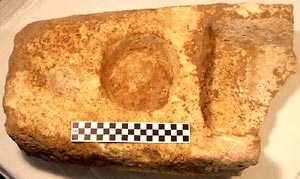 And then there was that odd large stone implement found at the bottom of a stone-lined silo. It was probably a former weight used to crush olives for olive oil, but the hole for the rope had been filled in with cement probably in Hellenistic times. The later users then carved two depressions into the stone, one circular and the other rectangular. Audrey, who is from southern California, decided it was ideal for nachos and salsa! Others were sure it was for humous and pita bread. It could have been used flat for food processing, or it could have been set upright as a symbolic depiction of something religious, though most of us could not figure out what that symbolism could be.
And then there was that odd large stone implement found at the bottom of a stone-lined silo. It was probably a former weight used to crush olives for olive oil, but the hole for the rope had been filled in with cement probably in Hellenistic times. The later users then carved two depressions into the stone, one circular and the other rectangular. Audrey, who is from southern California, decided it was ideal for nachos and salsa! Others were sure it was for humous and pita bread. It could have been used flat for food processing, or it could have been set upright as a symbolic depiction of something religious, though most of us could not figure out what that symbolism could be.
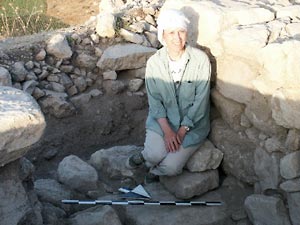 Just about the only satisfactory response to our questions was discovered in the square excavated by Mary Boyd and Kathleen Geraty. When they dismantled the stone fill in what looked like an earlier doorway, they indeed found that it was exactly that. But even this seemingly straightforward feature threw us for a bit of a loop. There, beside one of the door jambs was a single stone clearly in place. What purpose was it serving right there? Perhaps because Mary is a Methodist minister, the first thought that leaped into our minds (both of us had it at the same moment) was that it was to hold a collection plate as people left the building after hearing a stirring sermon. We didn't mind that the date of the door was Hellenistic (about 300-60 BC) and therefore pre-Christian, nor that there was nothing else suggesting a worship function for the surrounding walls and rooms. Such minor inconveniences are easily glossed over when we are inspired by the excavator. Last year, Mary's assistant had found three Hellenistic lamps and Mary was feeling a bit left out. This year she got her revenge. She finally found one in the door way. Perhaps it was to allow people to see the collection box.
Just about the only satisfactory response to our questions was discovered in the square excavated by Mary Boyd and Kathleen Geraty. When they dismantled the stone fill in what looked like an earlier doorway, they indeed found that it was exactly that. But even this seemingly straightforward feature threw us for a bit of a loop. There, beside one of the door jambs was a single stone clearly in place. What purpose was it serving right there? Perhaps because Mary is a Methodist minister, the first thought that leaped into our minds (both of us had it at the same moment) was that it was to hold a collection plate as people left the building after hearing a stirring sermon. We didn't mind that the date of the door was Hellenistic (about 300-60 BC) and therefore pre-Christian, nor that there was nothing else suggesting a worship function for the surrounding walls and rooms. Such minor inconveniences are easily glossed over when we are inspired by the excavator. Last year, Mary's assistant had found three Hellenistic lamps and Mary was feeling a bit left out. This year she got her revenge. She finally found one in the door way. Perhaps it was to allow people to see the collection box.
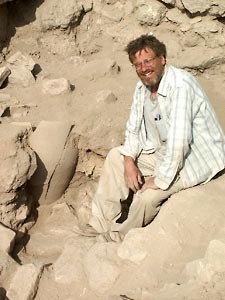 Excavation did not slow down in Field B, either. If anything, it sped up. John Raab, Pawel Surowka and Candace Jorgensen showed clearly that a large store jar was in a pit below the floor of a building dated to the end of the Iron Age (around 550 BC). After carefully removing its contents, they brought it back to camp. It now lies in huge pieces near the pottery reading tables. They had to dig through a massive destruction layer to expose the jar and were forced to stop at a layer of dirt black with soot and carbonized wood. They are tantalizingly close to the surface and the goodies over which the destruction fell. Wait 'til next season.
Excavation did not slow down in Field B, either. If anything, it sped up. John Raab, Pawel Surowka and Candace Jorgensen showed clearly that a large store jar was in a pit below the floor of a building dated to the end of the Iron Age (around 550 BC). After carefully removing its contents, they brought it back to camp. It now lies in huge pieces near the pottery reading tables. They had to dig through a massive destruction layer to expose the jar and were forced to stop at a layer of dirt black with soot and carbonized wood. They are tantalizingly close to the surface and the goodies over which the destruction fell. Wait 'til next season.
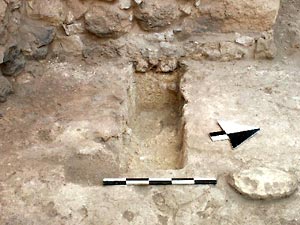 Wendell Bowes and James Hanson have moved to yet two more squares in their quest to excavate the largest number of squares in a season. Having completed the clearing of the pit as far as we found it safe to do so, they exited 8K02 and 7K92 and spent this week cleaning, clearing and probing the floor surfaces of the LB building in 8K00 and 8K01. It only took a couple of days to find the lowest floor surface through which they probed against one of the walls to discover that the house had been built directly atop the slightly sloping Middle Bronze rampart on the inside of the town. Since we want to preserve this rarest of specimens of Late Bronze architecture, this concludes the work we do in the southern two rooms of the building.
Wendell Bowes and James Hanson have moved to yet two more squares in their quest to excavate the largest number of squares in a season. Having completed the clearing of the pit as far as we found it safe to do so, they exited 8K02 and 7K92 and spent this week cleaning, clearing and probing the floor surfaces of the LB building in 8K00 and 8K01. It only took a couple of days to find the lowest floor surface through which they probed against one of the walls to discover that the house had been built directly atop the slightly sloping Middle Bronze rampart on the inside of the town. Since we want to preserve this rarest of specimens of Late Bronze architecture, this concludes the work we do in the southern two rooms of the building.
The team of Janelle Worthington, Nicole Murphy, Michal Kurzyk, and Christy Robinson spent several days removing the debris above a Late Bronze Age destruction dating to about 1300 BC and then removing the balk between their square and the one to the south excavated in earlier seasons. In doing so, they found another major wall of our Late Bronze building. Like the other walls of the building, it was preserved over three meters (about 10 feet) high. James Hanson joined them for part of Friday and, like Spiderman, carefully crept over the wall with his brush cleaning the stones. With at least one new room of the building (and probably another to the east), it's impressive enough to call the building a palace. Archaeologists don't need much encouragement to use that term.
In what must be the western extent of the room, Howard Munson and Carmen Clark found a Late Bronze Age juglet protected by fallen bricks in the destruction. Everyone working in the LB building is now disappointed that they will not be able to reach its floor this year. Wait 'til next season.
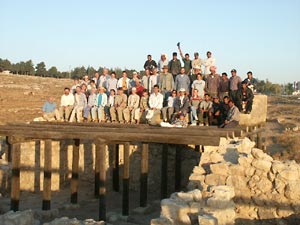 Somehow we managed to pack in a lot of activities other than archaeology during the week. On Sunday, most of us traveled into the Decapolis region. The Decapolis consisted of a series of ten Greek and Roman cities mostly in Northern Jordan. We first descended into the Jordan Valley to Pella where we saw ruins of the Civic Center besides remains from earlier periods. Then we followed the south bank of the Yarmuk River as we ascended to Umm Qays (ancient Gadara), visited the extensive Roman ruins there, and ate lunch high on the hill overlooking the Sea of Galilee.
Somehow we managed to pack in a lot of activities other than archaeology during the week. On Sunday, most of us traveled into the Decapolis region. The Decapolis consisted of a series of ten Greek and Roman cities mostly in Northern Jordan. We first descended into the Jordan Valley to Pella where we saw ruins of the Civic Center besides remains from earlier periods. Then we followed the south bank of the Yarmuk River as we ascended to Umm Qays (ancient Gadara), visited the extensive Roman ruins there, and ate lunch high on the hill overlooking the Sea of Galilee. 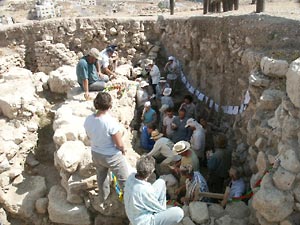 Not many restaurants have a view quite like that. After lunch we visited the greatest of all the Roman cities in Jordan, Jerash with its columns by the hundreds, temples, theaters and oval forum. It was hot, but Jerash is fabulous. Some even got back to Jerash for the invitations-only opening ceremonies of the 2002 Jerash Festival on Wednesday evening, courtesy of Carmen's oud teacher whose orchestral and vocal group from the national conservatory performed in coordination with scores of dance school students in a splendid opening event. Queen Noor was there to welcome invitees who filled most of the southern theater.
Not many restaurants have a view quite like that. After lunch we visited the greatest of all the Roman cities in Jordan, Jerash with its columns by the hundreds, temples, theaters and oval forum. It was hot, but Jerash is fabulous. Some even got back to Jerash for the invitations-only opening ceremonies of the 2002 Jerash Festival on Wednesday evening, courtesy of Carmen's oud teacher whose orchestral and vocal group from the national conservatory performed in coordination with scores of dance school students in a splendid opening event. Queen Noor was there to welcome invitees who filled most of the southern theater.
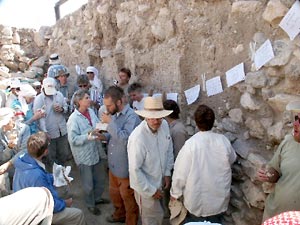 Tuesday was a busy day at the tell. Besides digging, we climbed up to the top of the Iron I pillared house for a picture as the sun was coming up. Second breakfast found us encompassing both ends of the food system - eating falafels and drinking Pepsi, Mirinda and Sprite in the bottom of the huge refuse pit which previously had produced 15,000 bones (up to ca. 25,000 by now). The Pit Party was arranged by Bowes and Hanson Excavation Company, Inc., and concluded with the annual discovery of tins of Field B imported Danish Butter Cookies buried (for who knows how long) in the floor of the pit.
Tuesday was a busy day at the tell. Besides digging, we climbed up to the top of the Iron I pillared house for a picture as the sun was coming up. Second breakfast found us encompassing both ends of the food system - eating falafels and drinking Pepsi, Mirinda and Sprite in the bottom of the huge refuse pit which previously had produced 15,000 bones (up to ca. 25,000 by now). The Pit Party was arranged by Bowes and Hanson Excavation Company, Inc., and concluded with the annual discovery of tins of Field B imported Danish Butter Cookies buried (for who knows how long) in the floor of the pit.
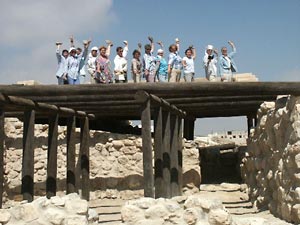
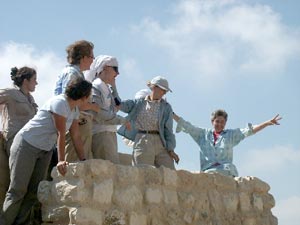
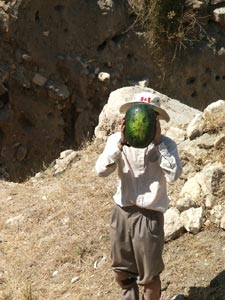
Then, after second breakfast, we returned to the house. All the women grabbed a grindstone fragment and again climbed to the roof of the building in order to throw the stones at a watermelon on the rampart below. Initiated last season, the Woman of Thebez Memorial Millstone Toss re-enacts the great biblical story in Judges 9 where the unnamed Woman of Thebez threw a millstone at Abimelech and crushed his skull. For the full story of this event, check out the article by Denise Herr and Mary Boyd in the January/February issue of Biblical Archaeology Review (BAR). This season, most of our women missed "Abimelech's" head and had to have a second (or was it third or fourth?) go at it. Some of the stones were collected from around Abimelech for a second toss, likely an unlikely possibility in the biblical story. The AP wire service came out this week with an account of the BAR article.
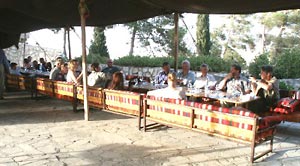 The fitting close to the week took place Friday evening at Seven Hills Restaurant with our traditional celebratory mensef, the famous Bedouin feast usually eaten at weddings and other festive occasions. Eaten under a goat's hair tent set up on the grand terrace overlooking the Madaba Plain, there were two main courses - traditional mensef and a vegetarian maqluba.
The fitting close to the week took place Friday evening at Seven Hills Restaurant with our traditional celebratory mensef, the famous Bedouin feast usually eaten at weddings and other festive occasions. Eaten under a goat's hair tent set up on the grand terrace overlooking the Madaba Plain, there were two main courses - traditional mensef and a vegetarian maqluba.
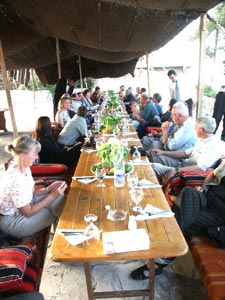 The mensef consisted of large pieces of boiled lamb scattered over a large platter of mounded rice and topped with a goat yogurt sauce with slivered almonds and pine nuts roasted to perfection. Most of us find it very tasty, especially when we eat it in the traditional manner, gathered around the large serving tray dipping our right hands into the mixture, forming balls of it with our hands and popping it into our mouths. Unfortunately, the restaurant, correctly assuming some of our people might be a bit squeamish about it, omitted the gaping jaws of the lamb which traditionally decorates the top of the platter. The guest of honor is supposed to get the eye. We will have to speak to them about that omission for future feasts. Wait 'til next season!
The mensef consisted of large pieces of boiled lamb scattered over a large platter of mounded rice and topped with a goat yogurt sauce with slivered almonds and pine nuts roasted to perfection. Most of us find it very tasty, especially when we eat it in the traditional manner, gathered around the large serving tray dipping our right hands into the mixture, forming balls of it with our hands and popping it into our mouths. Unfortunately, the restaurant, correctly assuming some of our people might be a bit squeamish about it, omitted the gaping jaws of the lamb which traditionally decorates the top of the platter. The guest of honor is supposed to get the eye. We will have to speak to them about that omission for future feasts. Wait 'til next season!
But even now, it is being ...
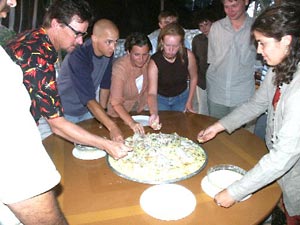
Overheard at `Umayri (and around town):
"stratiglaughable" - Field H discussants, trying with good humor to understand the complex stratigraphy of the late Iron I surfaces, cobble levels and earth layers where the shrine models were found.
"It was worth it." - Jerash festival attendees, even after sitting on seats of stone through a two-hour delay plus the program of the opening ceremonies.
"This is not my area." - Muqabulayn police officer, convinced that the location of a minor accident involving Jeepers in which some picnicking children tossed rocks randomly from a five-meter-high road-cut cliff onto the airport freeway late at night into heavy traffic, smashing the windshield, but otherwise doing no harm, was not in his territory, thus obviating the need for him to write up a report for insurance purposes and necessitating our travel to another police station. Since it was finally decided that the north-bound lane was indeed in their territory (after a discussion among several officers at the police station over a period of ten minutes), they decided this was indeed the place to provide the assistance we needed. In the end, the officer hand-wrote the report on a blank sheet of paper, using one sheet of carbon paper for the duplicate copy and sent us on our way. Jeepers was repaired by the end of the day.
"Next office, please." - Supervisor at the Parcel Post Office in downtown Amman, along with half a score of other postal employees happily sending Larry and Doug to eight (ten for Doug) additional offices on four floors in a convoluted order receiving stamps and paying customs fees in a couple of locations to retrieve a manuscript mailed from Europe and a set of MPP volumes sent by Andrews University Press to be given to one of our land owners as a gift.
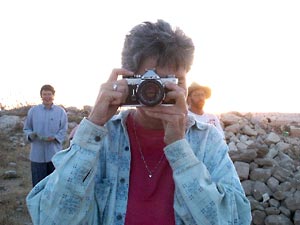 "O Bob, hey Bob, what do you think you're doing, Bob?"
"O Bob, hey Bob, what do you think you're doing, Bob?"
- Kathleen Geraty, for some reason identifying Doug Clark with her dog, Bob, whom she tried unsuccessfully to photograph.
Overseen at `Umayri:
Notes from Pit Party
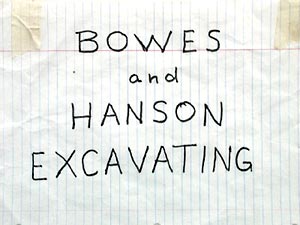
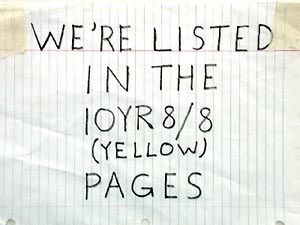
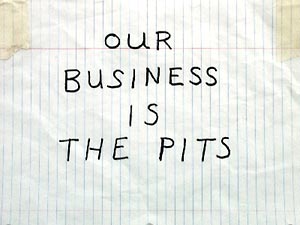

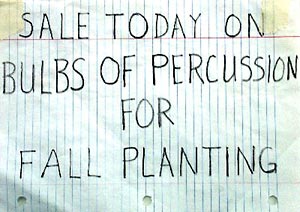
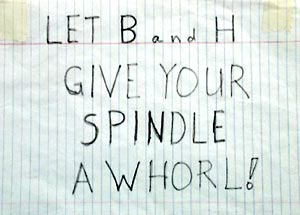

Overdone at `Umayri:
End of Season vortex of activities -
- Friday evening mensef at the Seven Hills Restaurant overlooking Tall al-`Umayri USaturday evening Ethnomusical and "Talent" Show (watch for a complete report of this and the following events in the final edition of the Weekly Report)
- Sunday evening Dead Sea Frolic
- Monday evening MPP Lecture and Reception at ACOR
- Monday through Wednesday close-down in the field
- Wednesday through Friday close-down at ATC and arrangements for container shipment (likely 250 red crates)
- Wednesday through Friday departure from Jordan for most MPPites